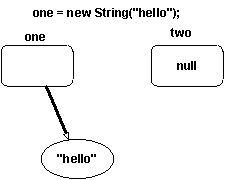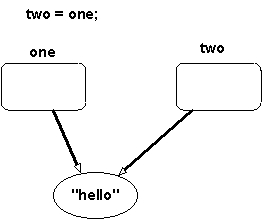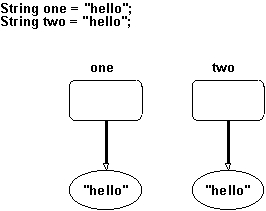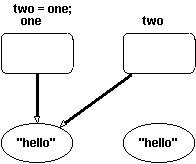
public void method1(); public void method1(int joe);are different.
public void changeBatteries()
{
battery = new Battery[numbatts];
for(int i=0; i < numbatts; i++)
battery[i] = new Battery(battype);
} // changeBatteries
battery can be treated as a parameter to the function. There is a pointer
to the data in the class instance available called this. So the
variable above was usable as
this->battery;
Functions can take arguments and can return results. The general form of a function in Java is
return_type
func_name(type1 arg1, type2 arg2,...)
{
// code for the function
}// func_name
A function can have no arguments. In Java,
a function is called by using its name followed by a parenthesized list
of arguments.
// Convert Fahrenheit to Celsius
float
ftoc(float ftemp) {
float ctemp;
ctemp = (((ftemp -32 ) *5) / 9.0 );
return ctemp ;
} // ftemp
The return type is float. This means that anywhere a float can be used, a call to this function can be used. Its name is ftoc and it takes one argument, a floating point number. At the end, it returns a float value. In between the braces is the code that implements the function. Variables can be declared inside the function that are local to the function. This means that the variables, like ctemp, are only used inside the function. This variable ctemp would be different from another variable ctemp used somewhere else in the program. A few other comments. If the function doesn't return anything, the return type is void.
Some details about the return statement.
If the function doesn't return a value, the return statement is optional
as a return occurs when the end of the function is reached. But a return
statement can be used if you want to exit the function early. In this case,
the form is just return; If there is a value to return,
return expr;
A function can return only one value.
new_temp=ftoc(32.0);
When this is executed, the control transfers from where the call to ftoc is in the code to the beginning of the code in the ftoc body. The variables described in the function header are set with the values in the function call. The variables in the function header are called the formal parameters. The values in the call to the function are called the actual parameters. The formal parameters are like local variables in the function code. The code in the function is executed in the usual order. When a return statement is executed, control goes back to the main program just at the point it left. If the function returns a value, then it is as if that value was put in place of the function call. So if the actual call was like this
temp = ftoc(32.0); // note the use of an float constantThen control starts at the top of the ftoc() function. The formal parameter is a float. All the arguments to the function are evaluated before the code is executed. Then the formal parameter, ftemp is set to the value 32.0. The arithmetic is done using the value in ftemp. The result is stored in the local variable ctemp. In this case, the value is 0.0. The return statement sends the 0.0 back to the calling function. So the program acts as if the line above was changed to temp = 0.0; Then the program goes on from that point as if it had never called the function.
ftemp=0.0;this would have no affect on the value of rtf. This is because ftemp is a local variable and is not related to rtf.
The other main method is pass-by-reference. Instead of a copy of the value being passed, a reference to the actual parameter is passed. This means that if the formal parameter is changed, In Java, this happens whenever an object is passed. We don't make a copy of the object, we pass a reference. In this case, if the reference is used to make a change, the actual parameter is accessed directly and thus can be changed. For example, methods on the referred object could be called which would change the state of some instance data. Or maybe the instance data is public. But in any case, if we change the local variable (the formal parameter) to refer to another object, this will not effect the actual parameter.
References can be used outside of function calls. In this case they are a kind of alias of another variable.
There is an example that demonstrates this in Chapter 5 of the book. The code is on the CD but I have linked it in here.
//********************************************************************
// BinaryOp.java Author: Kent Archie
//
// Demonstrates the use of binary methods and command line args
//********************************************************************
class BinaryOp
{
public static void main (String[] args)
{
String one = "hello " , two = "there.";
System.out.println(one.concat(two));
/* now concat the args on the command line.
Each element in the args array is a String object.
Note that the phrase args[0].concat(" ") is
a string object so has methods we can call
*/
System.out.println(args[0].concat(" ").concat(args[1]));
} // main
} // BinaryOp
If we run this, we get
C:\depaul\cs212\web\examples>javac BinaryOp.java
C:\depaul\cs212\web\examples>java BinaryOp
hello there.
Exception in thread "main" java.lang.ArrayIndexOutOfBoundsException
at BinaryOp.main(BinaryOp.java:14)
C:\depaul\cs212\web\examples>java BinaryOp kent archie
hello there.
kent archie
When defined, a reference has no particular value. This means it doesn't point to a particular object. Java supports a special constant called null to help with this.
String str;This create a variable that can hold a reference to a String object. But it neither holds one now nor is a String object created. To indicate that this variable is unused at the moment, we can set it to null.
str = null;References are not initialized in Java. This is why you usually see them associated with a new statement. Some more examples.



if(one == two)
System.out.println("they are equal");
else
System.out.println("they are different");
It would print they are equal.
This is because the two references are referring to the same object.
In this next example, we create two string objects that are different but
contain the same string.

Now let's get rid of one of them by assigning one to the other.

One of the purposes of interfaces is to provide a common set of methods for a set of classes. An example might be that there are many ways to represent the idea of a book. There are traditional paper based books, there are several kinds of e-books and there are web books. These would all be represented by different classes. But in order to call itself a book, it must provide methods to go to a specific page, save the readers place and other things. Building an interface to specify these methods would ensure that anything calling itself a book would have at least these methods. A class that implements an interface can have other methods that are not specified in the interface. In this case, the interface would look something like
public interface book
{
public int howManyPages();
public void goToPage(int pg);
public void savePlace();
}Interfaces also help support polymorphism. We can create variables of the interface type. These variables can contain any object of a class that implements the interface. So if we had
public class ebook implements book
{
public in howManyPages()
{
// code to get the number of pages
} // howManyPages
// other interface methods
public void search(String str)
{
// code to search for a string
} // search
} // ebook
public class wbook implements book
{
public in howManyPages()
{
// code to get the number of pages from a web book
} // howManyPages
// other interface methods
public void search(String str)
{
// code to search for a string in a web book
} // search
public String getURL()
{
// code to fetch this pages URL
} // getURL
} // wbook
If we have a variable of type book like
book tome;, we can set it to point to objects of type
ebook like this
tome = new ebook();.
If we invoke the pages method like this
int p = tome.howManyPages
it would call the version in the ebook class.
The type of the object determines what is done, not the type
of the reference.
If we later set the variable to tome = new wbook();,
and then as for the pages, we execute the version of the method
defined in the wbook class.
However, if we tried to invoke the non-interface method search(), like this: tome.search(); it would fail. The interface variable can only access methods specified in the interface. To do this, we have to cast the reference to the right class like this (ebook)tome.search();. We can also make the parameters to method use the interface type. This would allow the method to accept any object that implements the interface. The formal parameter would act just like the interface variable declared above.